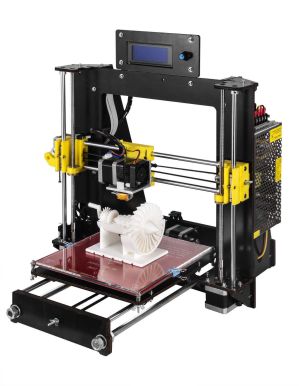 Updates
Updates
2018/03/26: Initial post with description, assembling and first test print.
2018/03/27: Board identified as “Anet A1284-Base-Control Board V1.0”. More details on adding a printer to Cura and included brief video of the first print.
2018/03/28: fan duct added, replaced broken extruder fan (see section “Fixes & Upgrades”)
2018/03/29: added white LED near nozzle, XYZ calibration cube fan vs fanless printing.
2018/03/30: added serial plate and label plate, calibrating X and Y axis properly.
2018/04/19: cables sorting
2018/04/23: printed X gantry/axis parts and replaced them
2018/04/25: refasten screws & cable binders of Y carriage
Introduction
Back in 2013 I’ve got pulled into 3D Printing and did some work on
- theoretical issues (2013) and
- software (coauthor of OpenJSCAD.org, 2013-2016)
- and briefly cooperated with a small 3d printer company, where I printed my first pieces as part of testing 3d printers
but I didn’t own a 3d printer myself until 2018/03/21 – roughly 5 years later – when I ordered an “DE A8 3D Printer DIY i3 Upgradest High Precision Reprap Prusa 3d Drucker” for EUR 99.00 (apprx. USD 120) shipment from and to Germany included – that is by far the most affordable 3d printer I ever saw (2018/03).
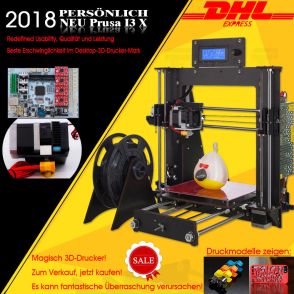 As the product image shows – it is hastly translated from english to german, and doesn’t make a very serious impression. After some research I realized it’s an CTC DIY Prusa i3 aka CTC DIY i3 Pro B (product link valid 2018/03/22) sold for USD 140, produced by Zhuhai CTC Electronic Ltd located at Zhuhai City, Guangdong, China – located at another peninsula west of Shenzen and Hong Kong. On further investigation I found out that the CTC DIY I3 Pro B is a clone of Geeetech DIY I3 Pro B, which is advertised as “Geeetech I3 pro is based on the Reprap open source project. Geeetech I3 is highly recommended for students and beginners who want to start journey in 3d printing technology.”
As the product image shows – it is hastly translated from english to german, and doesn’t make a very serious impression. After some research I realized it’s an CTC DIY Prusa i3 aka CTC DIY i3 Pro B (product link valid 2018/03/22) sold for USD 140, produced by Zhuhai CTC Electronic Ltd located at Zhuhai City, Guangdong, China – located at another peninsula west of Shenzen and Hong Kong. On further investigation I found out that the CTC DIY I3 Pro B is a clone of Geeetech DIY I3 Pro B, which is advertised as “Geeetech I3 pro is based on the Reprap open source project. Geeetech I3 is highly recommended for students and beginners who want to start journey in 3d printing technology.”
Technical Specifications
- Method: FDM (Fused Deposition Method)
- Volume: 200mm x 200mm x 180mm (X Y Z)
- Printing Resolution: 100um
- Layer Precision: 50-100um
- Filament Diameter: 1.75mm
- Material: PLA (platform 50-60C), ABS (platform 110C)
- Nozzle Diameter: 0.4mm
- Mechanical Positioning:
- XY: 11um
- Z: 25um
- Speed Positioning: 300mm/s, 100mm/s
- Recommended Nozzle Speed: 35-40mm/s
- Power: 220V / 80W
- Connectivity: USB & SD Card
- Product Size: 36cm x 38cm x 43cm
- Transport Package: 50cm x 42cm x 23cm, 9.13kg
(Numbers taken from the flyer 2018/03/24)
Unpacking
After 2 days, after ordering on Ebay.de, it arrived with DHL, a 9kg (20lbs) package.
The package is well composed, most parts are marked, some of the labels didn’t stick to the parts though. The controller board is orange with an ATMEGA 1284P in the center, with all connectors well labeled – it seems it’s loosely identified as “Anet A1284-Base-Control Board V1.0”. Gcode M115, which identifies the firmware, responds as
Marlin V1; Sprinter/grbl mashup for gen6 FIRMWARE_URL:https://github.com/ErikZalm/Marlin/ PROTOCOL_VERSION:1.0 MACHINE_TYPE:I3 Pro B EXTRUDER_COUNT:1 UUID:00000000-0000-0000-0000-000000000000
The shipped 3d printer does not match the photos in the Ebay posting, therefore the product link to the CTC manufacturer is also not correct. It turns out it’s either another version of the “CTC DIY I3 Pro B” or a remix of another line, the included manual states it’s a “CTC DIY Printer” by “Zhuhai CTC Electronic Co., Ltd”.
Here the main differences:
- LCD has 5 buttons – advertising shows a dialer with integrated push button
- controller board is orange with green power connectors, stepper motors drivers are soldered on (cannot be replaced) – advertising shows board with replaceable stepper motor drivers
- heating bed is aluminium with blue tape already on – advertising shows orange/red heating bed with a glass plate
The only things I thought was missing was
- the small fan near the controller board, the screws and distance tubes were included (stepper motors drivers have passive coolers attached), perhaps they meant the fan attached to the extruder (which is included) . . .
- on/off switch for the main power, a small hole (~4.8cm x ~2.6cm) is prepared, but none was included
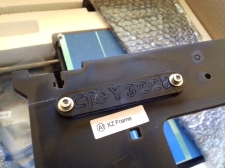 The XZ frame comes with a small plate “CTC Y 3228”, which likely is the serial number of this frame/printer.
The XZ frame comes with a small plate “CTC Y 3228”, which likely is the serial number of this frame/printer.
Assembling
The included manual (diy-manual) on the CD is cumbersome to read – so here the assembling procedure which worked for me and for my own future reference:
Mechanical Assembling
I realized to first assemble mechanically and then electrical (wires) is the best procedure; also re-fasten all screws of the preassembled pieces to ensure the stability.
Here as reference the 3 axis as mentioned further below:
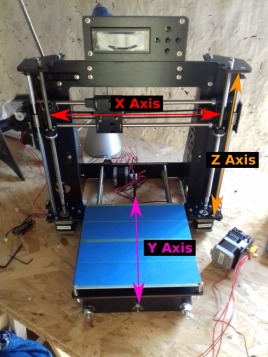
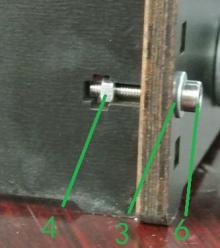 use the two sheets/feets so the XZ frame stands upward, the larger ventilation grill comes to the right-hand side when looking to the front; use M3 with washer on the front, and the nut within the sheets/feet; don’t tighten it too much otherwise you will crush the wood.
use the two sheets/feets so the XZ frame stands upward, the larger ventilation grill comes to the right-hand side when looking to the front; use M3 with washer on the front, and the nut within the sheets/feet; don’t tighten it too much otherwise you will crush the wood.- the right-hand middle screw at the XZ frame has to be flat without a washer this screw otherwise crashes later with the X axis moving up/down the Z axis.
- add the two Z axis stepper motors, the one with the end stopper switch comes at the left-hand side, again M3 with washers and nuts.
- add the X axis:
- the X axis stepper motor goes on the left-hand side
- insert the threaded rods, the flexible tubes looking downside (thread them from bottom to top) – a bit time consuming
- the X axis with the threaded rods push unto the flexible couplers on the stepper motors, at least 1cm or 1/2″ on the stepper motor, leave 0.5-1.0cm or 1/4″-1/2″ spacing between stepper motor shaft and threaded rods (I have seen others leaving little space, but larger distance worked for me so far)
- twist threaded rods so X axis is visually horizontal (fine tuning comes later)
- insert the smooth rods (no threads), the holes at the stepper motors require some filing (use the included grater), the smooth rods get pushed apprx. 5mm in
- insert the top ends which fixates the smooth rods but not the threaded rods (those have to stay floating)
- add Y axis, since it’s mostly prepared already you just lay it into the XZ frame, with the stepper motor behind, two additional (unfastened) sheets to attach the Y axis with its larger threaded rods to the XZ frame
- add printer head: take it apart (first the nozzle and then L shaped support), use prepared M3 to attach the L and then add the printer head (without nozzle) to it, and then add the nozzle again (screw it with the cable looking left-hand side, once fully screwed on they look on the left-hand side again).
- add LCD screen on the top of the XZ frame
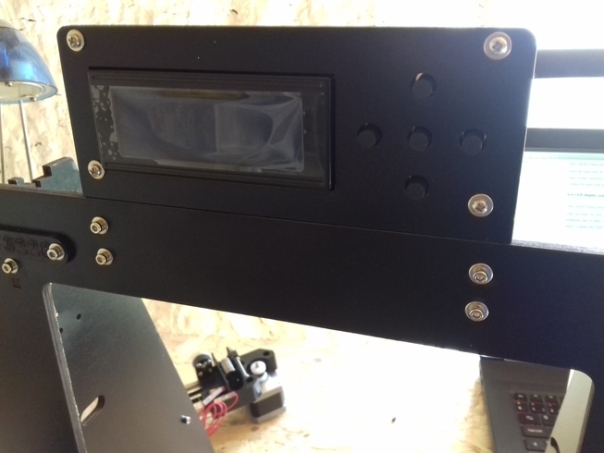
- add power supply on the right-hand side (looking from the front), just three M3 (one corner of the power supply is in the air), the electrical connectors are looking downward
- add controller board on the left-hand side
this finishes the mechanical assembling.
Electrical Assembling
Attaching all the cables to the controller board is easy since all connectors are labeled:
- add main 12V power from the power supply to the controller board
- attach the 2 long stepper motor cables (one end fits stepper motor, other connector to board – not interchangeable) to
- the right Z axis stepper motor (not moving)
- the extruder stepper motor (moving)
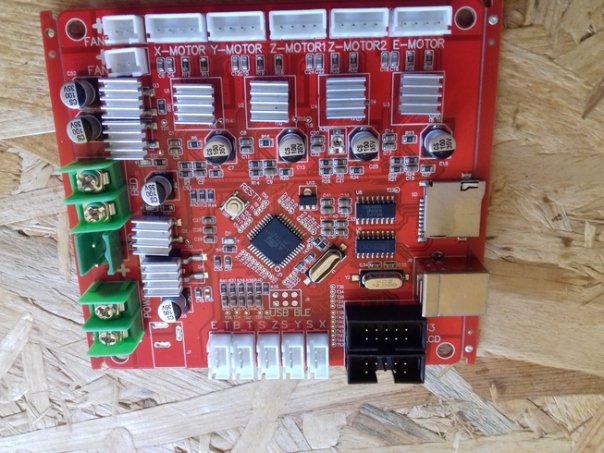
- attach the shorter stepper motor cables to
- the left Z axis stepper motor (not moving)
- the X axis stepper motor (moving)
- the Y axis stepper motor (not moving)
- attach the thermistors
- E/T: extruder thermistor
- B/T: bed thermistor
- attach the stopper switches:
- S/X: stop X axis
- S/Y: stop Y axis
- S/Z: stop Z axis
- attach extruder fan to “FAN2” on the controller (always on, but anoying but if you print larger pieces, the extrude fan must be running at first layer already)
- attach heating bed power to “BED” (polarity doesn’t matter here)
- attach extruder heating power
- attach LCD display with marked “LCD” on the controller (one connector aside remains empty)
- attach main power cable 110V / 220V to the power supply (don’t plug power yet): european standard: green/yellow = GROUND(3), blue = NEUTRAL(2), brown = LIVE(1)
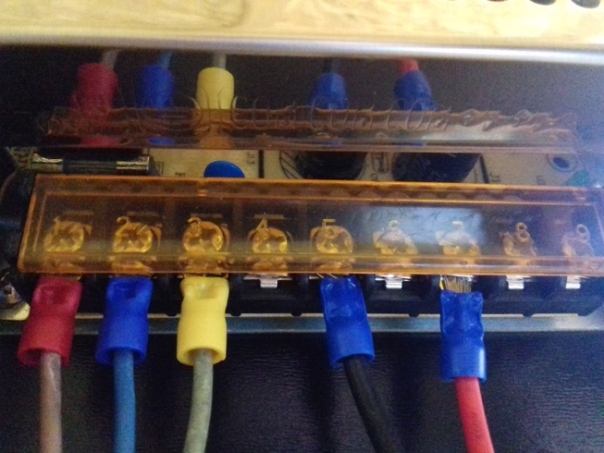
before you bundle the cables, control all connections again – missing or mixing up just one connector can damage the 3d printer once powered on.
Make sure the correct voltage 110V or 220V is chosen at the power supply (default 220V).
As next bundle
- all wires from the print head, with the black plastic wire bundler, these wires move the most
- all wires from the heating bed (heating and thermistor) with zip ties, and slightly lift them up so they don’t lay on the Y axis frame near the bottom otherwise the zip ties will eventually hang themselves there and block Y movement
- bundle the other wires neatly with isolated wires or
zip tiesspiral cable wrappers (only one is included, so get 2m extra) – on a 2nd thought avoid zip ties as they tend to hang somewhere when on moving parts
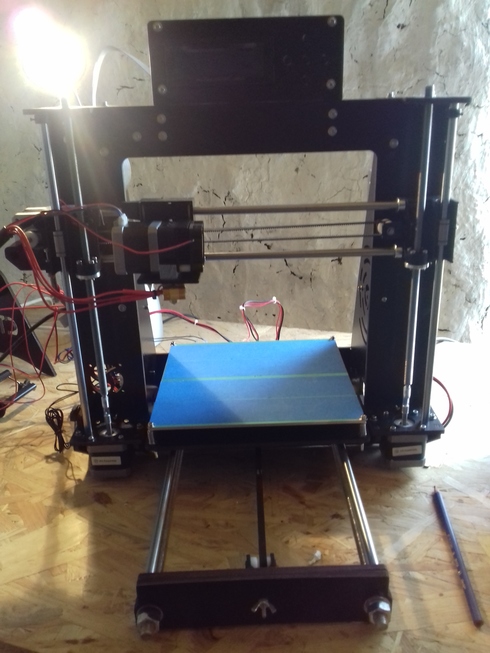
Adjusting X axis Height
This part is crucial for the geometric accuracy of all your prints:
- use any kind of item with a certain length, a pencil, a stick, or a ruler – whatever, long and short enough to match the height of your X axis (moving up/down the Z axis)
- put the item on the bottom of the left Z axis stepper motor and adjust the height manually by twisting the Z axis manually until the item touches the X axis; you might have to adjust the right side as well to stay somewhat horizonally
- now move the item to the right side of the X axis, and measure the same distance and adjust the height of the right side
- now both sides have the same distance to the bottom (the stepper motors at the bottom) – which means, the X axis is now perfectly horizontal
As next make sure the Z axis stopper on the left-hand side near the bottom, that screw coming down on the X axis is fully extended: move the nuts up so the screws extends down and reaches the stopper early.
Adjusting Printing Bed aka Bed Leveling
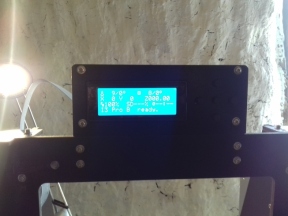 When all is assembled mechanically and electrically, you turn on the machine; the LCD display should light up in blue with white letters.
When all is assembled mechanically and electrically, you turn on the machine; the LCD display should light up in blue with white letters.
Note: when the printer is powered on, the stepper motors become active and hold their position, you can’t or shouldn’t move the X or Y axis manually anymore, unless you choose in the menu “Prepare -> Disable Stepper Motors”
- choose “Prepare -> Auto Home”; and carefully watch the printing head moving left to X axis home, moving backward with Y axis to home and Z axis downward:
- if the screw hitting the Z axis end stopper missed, push the stopper before with your fingers, you otherwise damage your printer
- if the screw hits the stopper, good
- you likely have too much space between the nozzle and the printing bed
- adjust the screw hitting the stopper to minimize the distance of the nozzle to the end, hit “Prepare -> Auto Home” until the nozzle is within 0-3mm distance of the bed
- hit “Prepare -> Disable Stepper Motors”,
- adjust the bed with the manual fly nuts, put a piece of paper on the bed, and adjust distance so the nozzle barely touches the paper (left/front side of the bed), then
- move the printer head on the X axis manually to the right side, and adjust right/front side alike , then
- move the Y axis forward manually so you reach the end of bed (right/end side), adjust height, and
- move the printer head on the X axis so you reach (left/end side) and adjust the height as well,
- and repeat it once more to make sure the nozzle is 0.1mm distance from the bed (that’s the thickness of a piece of paper)
You have now adjusted the printing bed, you are ready to print now.
Installing Cura
The included Cura slicer and front-end on the CD (as in my case) is of version 14.07 (roughly 5 years old) and has no Linux version, as of 2018 I can’t even find a binary anymore for Linux – so I installed the latest on my Linux laptop; you download Cura-3.2.1.AppImage or something newer, once downloaded you execute it direct (it does no install) with right mouse click and “Execute”; under Windows or Mac it may install differently.
Once Cura started up:
- add a new printer
- choose “Other” -> “Prusa i3 Mk2” as type
- name it “CTC DIY i3 Pro B” or something like this
- Printer Setting:
- enter as printing volume: X = 200mm, Y = 200mm, Z = 180mm
- select “Reprap” or “Marlin” as GCode flavor
- select “[x] Heated Bed”
- you don’t have to edit the Start or End Gcode
- Extruder Setting:
- define the nozzle 0.4mm and filament 1.75mm diameter
- open xyzCalibrationcube.stl (download .zip and unpack it)
- it will slice right away once it appears on the virtual printing bed
First Test Print
Best choose PLA in Cura as a first test print, it’s easier to print.
- Connect the controller board with your computer with the USB cable.
- Go into the menu of LCD display (with 5 buttons, “up/down/left/right” and “select” at the center), and choose “Prepare -> Preheat -> Preheat PLA 1”, and wait 60 seconds, then
- cut the filament so you get a sharp pointy end
- push the filament into the printing head (the 2nd hole closer to you)
- start the print of the “XYZ Calibration Cube” on your computer:
- choose triangle near right-side bottom of the CURA window, deselect “save to …” but change to “print to USB”
- then press that button
- the printer will now start to heat the bed to 55C (takes longer) and the printer head (faster heating because it’s a smaller heating mass) to 210C
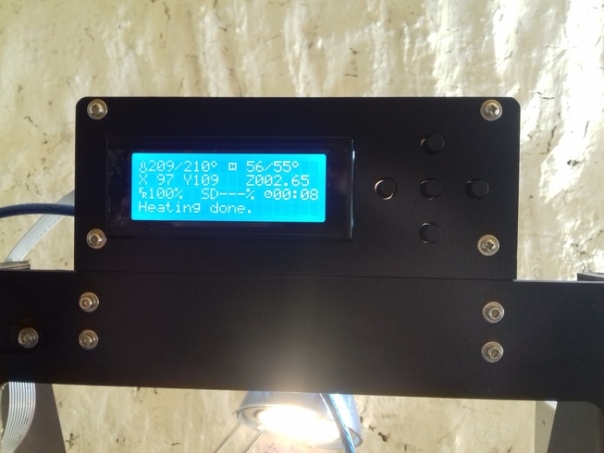
- after 60-90 seconds when those temperatures are reached your print will start
- it first auto home (X=Y=Z= 0) and then will try to push out some PLA just to clear the nozzle, at your first print this might not happen right away, because the filament isn’t far enough through the nozzle yet
- it will try to print a circumference of the test print, wait and see if any PLA comes out of the nozzle, if you see the actual cube or test print you chose is about to be printed, and still no PLA comes out, try to push the filament into the printer head or abort the print and when the printer head is stopped, push the filament into the printer head (perhaps try to pull and push again to see where the filament is blocked)
- start the test print again, eventually the PLA comes out of the nozzle
- if no PLA comes out, repeat 5.1
- if PLA comes out, and attaches to the bed, you likely have a successful first print ahead
- if PLA comes out and doesn’t attach to the bed but creates a mess, abort the print and check “Adjusting Printing Bed” again
In my case the bed was too close to the bed, so the test cube was too firmly attached to the tape that I ripped the tape off the bed when removing the test cube.
The very first test print worked extremely well, beyond my expectations – no Z wobble at all, some stringing at “X” and “Y” though.
Fixes & Upgrades
Filament Guide & Cleaner
- filament guide and cleaner:
- 2nd filament guide for holding the wires of the printer head
Extruder & Part Fan
I had attached the extruder fan to “FAN2” which is an always on 12V source (surely can be turned off), the fan ran for few minutes and died; I replaced it and attached it to “FAN1” which turns on after 2nd layer of printing which is sufficient and kept it there, as I printed once a large piece which caused the extruder heat up so much that filament got stuck – so it’s remained on “FAN2” (always on).
- 40mm fan duct for CTC Prusa (printed with “support” enabled) as part fan attached electrically to extruder fan which is connected to “FAN1” on the controller, which turns on at 2nd layer printing
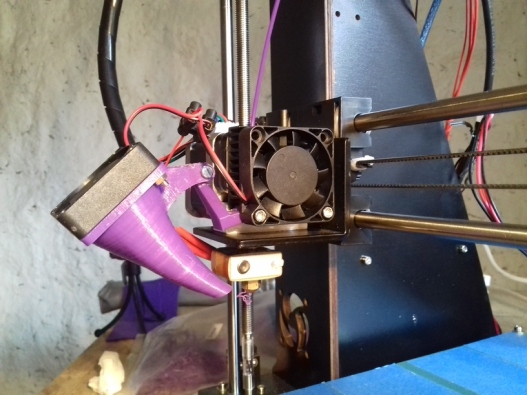
- after the 40mm fan duct “part fan” attached the prints significantly improved, for example #3dbenchy I would have dared to print without fan, still a bit stringing but overall a very good print:
- fan vs fanless printing side-by-side:
White LED
Adding white LED near the nozzle for better viewing, attached to “FAN2” on the controller board (always on), 1K resistor in series with LED on 12V.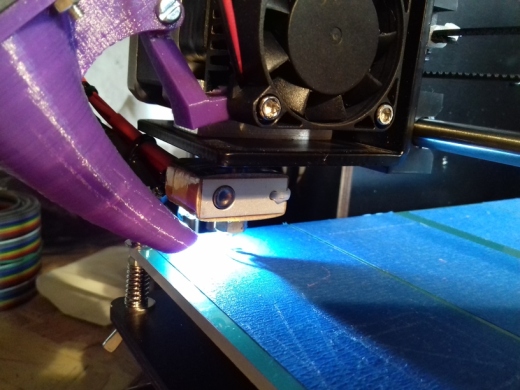
Labels
I thought the printer lacks proper labels, also one of the reasons it’s sold in so many variants and you don’t know what kind of “CTC DIY I3” you get.
- label plate “CTC DIY I3 Pro B” (just press “Generate STL” -> “Download”) or download STL
Hint: your printer must be calibrated, even 1% margin will make the label not fit – best print 2-3 layers first, then abort print and measure hole-to-hole (centers), and then rescale piece (100%/your-length*157.5) in Cura so the distance of the holes fit 157.5mm distance finally – see next section “X & Y Axis Calibration”. - serial plate “CTC A9999” and check Description, edit your serial number & press “Update”, then press “Generate STL” -> “Download”
X & Y Axis Calibration
When I printed the labels I realized my X and Y axis were off by 1.49% each, which made more than 2mm on 150mm distance (way too much); I printed out an “L shape” of 150mm length 10mm wide X and Y axis, and measured the length, apprx, 147.8mm. I went into the LCD menu “Control -> Motion -> XSteps/mm & YSteps/mm”:
Current settings:
- XSteps/mm: 78.74
- YSteps/mm: 78.74
and calculated 78.74 / 147.8 (measured) * 150 (should be) = 79.91
New settings:
- XSteps/mm: 79.91
- YSteps/mm: 79.91
I printed out the “L 150mm” again, and remeasured: 147.8mm – it made no difference, checking back the settings they were reset back to 78.74. So, I could edit it, but it had no effect whatsoever . . .
Using Repetier helped as I was able to manually send Gcode without actually printing anything and checking back with the LCD menu, and so reconfigured it to enter “M92 X79.91″ which was set as “XSteps/mm 79.9” when reading back in the LCD menu – when I printed with Repetier the L shape again I ended up with 149.5mm instead of 150mm, still a bit off.
I decided to stay for now with Cura – as I’m used to it right now – and after some additional test prints I ended up adding following “Start Code” in Cura at the bottom of the existing code:
M92 X80.27 ; change xsteps to 80.27 per mm M92 Y80.27 ; change ysteps to 80.27 per mm
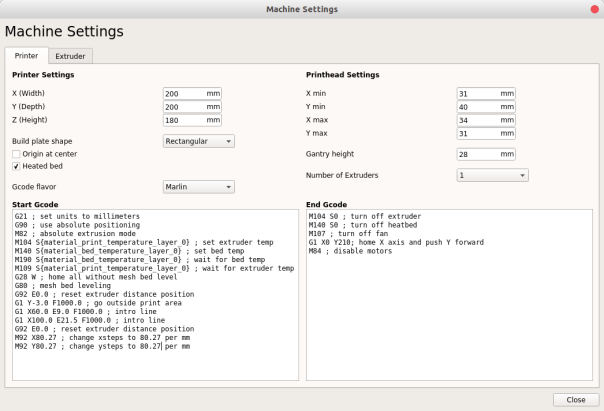
That finally worked, the L shape of 150mm ended up with 150.0mm (+/- 0.2mm) as measured with a ruler.
Even though I printed out the 20mm calibration cube, the 1% or 0.2mm I could hardly see with the simple ruler (right, require analog or digital caliper) – the Z axis seems fine but needs verification as well.
Update 2018/04/25
After a lot of tuning, I ended up with this single line
M92 X80 Y80 E96
which sets X & Y Steps per second as well the extrusion flow (instead using 105 steps as the default and reduce by 95% you define E96 and stay with 100% extrusion flow).
Cables
I used some more cable spirals to sort the cables better and give them some kind of stiffness while still being flexible, e.g. the Y axis cable I lifted up so it stays flexible and won’t catch on anything while moving:
What’s left to do it is a cover over the controller board.
Replacing X Gantry/Axis Parts
I finally dared to print the X gantry/axis parts as enclosed on the CD I received, and replaced the black parts:
I had to remove the XZ Frame flatter screw as it touched the X pulley on the right side slighly at the same Z height – and I didn’t want X position errors at that particular Z height. Also, the Z Stopper seemed now too far on the right, and the screw pushing on the stopper too far on the right, so I printed a 10mm wide 5mm height cylinder with 2.8mm hole inside, which I screwed on the bottom of the M3 Z Stopper screw which extends the area and now reliably pushes the X Stopper switch.
Loose Screws & Cablebinders: Y carriage
After roughly a month of usage, the printed started to make noises, more so the bed leveling was almost impossible to perform, after each print the level was misaligned and I wondered. Finally I removed the heatbed and retighten all screws and nuts and refastened the cable binders which held the linear bearings of the Y carriage.
That made a huge difference . . . I was finally to print again 60mm/s and most of the stringing went away due the higher speed; I even printed at 80mm/s at still acceptable quality. The entire printer sounded now differently, it mad an immense impact to retightend those screws, it did not just affect Y axis, but also the X axis – and the overall prints are cleaner, more precise and I’m able to print at higher speeds without loss but actual gain of printing quality.
Conclusion
This 3D Printer is the low cost hobbyist or entry-level “maker” approach to 3D printing – and even when you end up with a broken printer, the parts are worth it as you likely are unable to source the parts yourself for less than EUR 100 with shipment.
Expect to invest heavily in regards of time to educate yourself and fine-tune your printer and extend it so it becomes easy to use.
It is worth it – but what you order might not what you get . . .
Notes
Material
- 1kg PLA “Sienoc” purple (2018/03): nice color, bed adhesion ok, printed at 200C, good flow
- 1kg PLA “Sienoc” black (2018/04): very good bed adhesion, fully opaque at 0.15mm layer already, very glossy, printed at 200C, very good flow
- 1kg PLA “Kaisertech” white (2018/04): adhesion ok, layers quite opaque (0.15mm partially transparent, 0.25mm already quite opaque), printed at 200C, flow not ideal
- 20 pieces/colors a 10m colored (incl. transparent, glowing, gold, silver) PLA of unknown brand (2018/04): 210-215C required, at 200C possible of non extruded filament (missing extruder steps) and therefore missing regions of material
Note: I will update this post with new discoveries and experiences, and see also additional blog posts with CTC DIY i3 Pro B tag.












































































By far the best write-up I’ve seen so far! Excellent job.
LikeLike
Hi, were did you find that Filament Guide?
LikeLiked by 1 person
I just added the link in the text: https://www.thingiverse.com/thing:2730001 – it suits to guide the cables as well.
LikeLiked by 2 people
Hi, I have this printer as well. But after a firmware update to marlin 1.1.8 the printer is f#¤%up and I cannot use it, makes a high sound when trying to home the z axis or print for that matter. Do you by any chance have the org. firmware or how to get it. Or even better a working Marlin firmware I can get? Nice post! BTW
LikeLiked by 1 person
I haven’t deal with updating yet, so I didn’t yet backup my firmware and I’m away for a week from the printer; you have the same printer with the orange Anet controller board? If so I recommend to read the Anet A8 forums for the config of Marlin. Let me know of your success 🙂
LikeLiked by 1 person
No. I did not backup the firmware. 😦 BUT, last night I found out why the printer was acting up. It turns out that the “standard” marlin a8 setting are all wrong. In my case, I had to invert the Z stepper, the E stepper and set the homing speed way down as I had set the Z step pr. mm to 2560.
Can you link to the “X Gantry/Axis Parts” you had on the disc, my disc was broken. 😦
BTW: The printer I got is the EXACT same one, with orange Anet controller and missing fan.
LikeLiked by 2 people
I uploaded the .stl https://nofile.io/f/r1yeA6O1goy/CTC.zip
LikeLiked by 1 person
@TREG could you provide the complete settings you are using wis marlin? I am thinking of flashing too because I would like to use auto-leveling…
Is there a way to backup the original FW before flashing?
LikeLiked by 1 person
Is there a driver or something I have to install on my Mac? I am not able to print via USB… The printer is not recognized by osx.
The Mico-SD slot is placed very bad behind all the cables…
I have orderd a sd-slot extender – but this might take several weeks until the shipment from China arrives.
LikeLiked by 1 person
I don’t know about Mac, best google for “Anet A8 osx support”.
LikeLiked by 2 people
Another question:
You have connected the extra fan to FAN2 – as I did.
Do you think connectig ist to FAN1 via a y-cable (or solderings something) might be better? So both fan will turn on after the first layer.
And FAN2 could be used for a controller board fan…
LikeLiked by 1 person
I changed it (again), I had a piece to print with a large first layer, and it did not work, stuck filament – I changed so the extruder fan to be on when the machine is on (FAN2) – I have to upgrade the firmware so it starts only when the nozzle heat is on. The part fan is connected to FAN1 which turns on 2nd layer print (as it should be).
LikeLike
Great walk through setting up your printer, it made my experience with mine so much easier! Thank you!
LikeLike
Hi man,
I got mine around a month ago, thanks for all the tips and information, are you still using it? … I have a small problem with Y axis, when the 3d printer ends printing something it “presents” the final printing by pushing the Y axis towards the front (like Y=0), but it kind of “crashes”, it doesnt stop smothly, not sure if I am explaining myself properly.
Additionally, did you noticed the X and Y of the 3D XYZ calibration cube are not perfectly fitted in the middle?, and the X has on the left side a kind of “resonance”, meaning you can see the X pattern reflected on the surface…
I have tried to leave the “height” of my impressions as smooth as possible but I keep observing undulations, perhaps my endless screws are a bit crooked.
thanks
-Alan
LikeLike
Y ending: either change Y dimension in Cura (or your slicer), or change the End Gcode to lower Y end position (200 -> 170 or so).
Not Centered: right, similar, change the X and Y (perhaps Z as well) dimension in the printer definition of your slicer, then your prints properly will be centered.
Resonance: I observed the fans attached to the printhead / X carriage causing uneven surface on X and Y; e.g. fasten Y carriage and losen a bit the X belt, so it dampens X movement a bit, that *might* help.
LikeLiked by 1 person
Do you have a good link for nozzle replacements. It is M6 but the rear hole is larger than most to accommodate the 3mm TPFE tub..
LikeLike
I don’t quite remember the search terms: “Anet A8 nozzles” or “MK 8 nozzles” (aliexpress or ebay) – I remember it took me quite some time to find matching nozzles, but then switched to E3D V6 and thereby switched to 4mm PTFE tube and easier sourcing parts thereby.
LikeLike
Thank you for the tips, now I am printing a piece, hopefuly it looks better with the setting, I will keep playing with them….
I also noticed that sometimes my extruder motor makes a noice, like a click! , no idea what is going on there, I disambled it all and put it together again but sometimes the noise like a “click” is there, also you can “feel” the click like in the whole structure…
I am also now using a crystal bed, lets see the results =)
LikeLike
The “click” is the extruder motor stepper missing a step, increase nozzle temperature +10C, if it still happens, reduce print speed a bit.
LikeLike
Hey man.. great write-up thanks a lot! It’s been very helpful.
I have this printer and I’m fighting to calibrate it correctly. Cubes are decent but the benchy is horrible.
Anyway.. quick question, seems obvious but not to me and found different opinions online. What direction should the fan be blowing air?.. For the extruder, should it be sucking air from the heatsink or blowing?.. Same question for the part fan. Just want to be sure fans are blowing the right direction.
Thanks again!
LikeLike
“benchy is horrible”, the question in *which* way, you have to describe it! 🙂
blowing air: the maximum air flow to what you want to cool, so most of the time you blow to a spot, and not pull air from a spot. I have converted all my printers for fang like coolers as https://www.thingiverse.com/thing:2175956 and remixes of it for the Volcano hotend – I tested ~6 part coolers, that one I linked is the best in my use cases.
LikeLike
Hahaha.. I think it is bad in many ways.. Best way is to see it. Check this out:
Any feedback welcomed.
Extruder is calibrated (same number as you described: 96), still pending PID calibration (don’t know if that’ll make much change). Bed level is working well.
I’m now printing at 30 mm/s but results are similar.
When I watch it printing, looks like the filament doesn’t stick well between layers. I mean, especially at the rightmost part of the benchy (bow) you can see the filament curling a little bit and every layer pushing that curl filament down..and then it ends up with a little mess (hope I made myself clear.. English is not my native language 😉 ).
Thanks for the fans clarification. Already printed the fan duct you mentioned in the blog post and waiting for a fan to install. Hopefully that will help with the printed quality.
Again.. huge fan of everything you write.. I’m actually enjoying hacking this printer a lot.. Sooner or later it’ll print better stuff 🙂
LikeLike
It seems wordpress.com removed the fb link . . . it seems to me there is no part cooler at all – the layers are still too hot when the next layer is put on as it seems to me. Once you have good part cooler things improve quickly and you discover new less severe problems 🙂 to fix.
LikeLike
Ooops.. were you able to watch the picture? If not send me a contact info (i’m bethus at gmail ) and will send you more data. Thanks a lot for the feedback. Yeah.. looking forward to installing the part cooler.
LikeLike
I saw the photo, in the comment approval the link was included, but after approval wordpress.com seemed to remove it, not sure why.
LikeLike
After installing the part cooler things are completely different. Can’t believe the big difference it made. Thanks a lot again for your help.
https://drive.google.com/open?id=1LJFreIILUFecrCAc-ueHQWjDqLc1LBY0
LikeLike
Excellent result!
LikeLike
Hello,
Thanks for all the tips and experience here. I bought my 3d printer some months ago, walls and wooble are gone by doing the following:
-8mm Stainless Steel Threaded Rod Lead Screw with T8 Nut for Prusa i3 3D Printer Z Axis Stepper Motor, 300mm (https://www.amazon.de/SOOWAY-Gewindestange-Leitspindel-Drucker-Schrittmotor/dp/B07GRWL443/ref=pd_lpo_sbs_60_t_1?_encoding=UTF8&psc=1&refRID=1VS05ZSPBDBTM7MREJY1)
-Changed the couplers for the steppers with the Rod Lead Screw for metallic ones (https://de.redbrain.shop/search?q=For+3D+Printer+Z&gclid=Cj0KCQjw2K3rBRDiARIsAOFSW_5OzSbRF1aCQndapQrBSy1E4Xg3LBIxs53OGZJlzJ69vWQjEzbbCLAaAvUEEALw_wcB)
-Installed smothers for the steppers (https://www.amazon.de/gp/product/B07BW8RTLJ/ref=ppx_yo_dt_b_asin_title_o05_s00?ie=UTF8&psc=1)
**********************************
For safety:
– I installed two MOSFETs for heat bead and hot end (https://www.amazon.de/gp/product/B07G34Q2VT/ref=ppx_yo_dt_b_search_asin_title?ie=UTF8&psc=1)
-I changed the Power supply for one with fan
**********************************
And just for fun, I am replacing the frame for Aluminum and:
– Replacing the current hot end for E3D V6 J-head Hotend 1.75mm (https://www.ebay.de/i/183913968659?chn=ps&norover=1&mkevt=1&mkrid=707-134425-41852-0&mkcid=2&itemid=183913968659&targetid=526297552030&device=c&mktype=pla&googleloc=9042423&poi=&campaignid=1669295758&mkgroupid=63847509999&rlsatarget=pla-526297552030&abcId=1139676&merchantid=115564790&gclid=Cj0KCQjw2K3rBRDiARIsAOFSW_71xWUtcd5capD_UvMgJRX0HMVNAJk44VXyrbnj0IwBxl_Gq4TSx_EaAkGfEALw_wcB)
-Replacing the bed carriage for a metallic one (https://www.ebay.de/itm/Hot-Bed-Y-Carriage-Anodized-3D-Printer-Support-Plate-Electronics-For-Prusa-I3-/123852449702)
-Replacing the slide bearings (https://www.amazon.de/gp/product/B01M4JZ81S/ref=ppx_yo_dt_b_asin_title_o04_s00?ie=UTF8&psc=1)
-Replacing the extruder and bedsprings like the following one (https://www.amazon.de/gp/product/B07TWK8FRN/ref=ppx_yo_dt_b_asin_title_o01_s00?ie=UTF8&psc=1)
-Replacing the pulleys for metallic ones (maybe I do this with the CTC now… I do not know, I am waiting for the F1 Belgium GP to start… let’s see if I have time hehe)
And my plan is to mount the stepper motor for the extruder on the frame, so only the hot end will be mounted on the X carriage.
Additionally, I am looking for the best option to mount the hot end, maybe I will print something or buy a metallic mount… I am not sure yet
The current status is, I have the frame and I printed the plastic parts, I am waiting for the carriage to disassemble my CTC! This is how it looks like: https://www.thingiverse.com/make:700416
Any comment, feedback or recommendation is very welcome, thanks again for the great work! BTW if you are around Munich let me know to drink a Weissbier
LikeLike
I forgot to mention some other upgrades to the current CTC Prusa i3,
-Of course the FAN duct and a fan for the hot end
-Replace the Z axis bracket, of course without the bearing!!!! (https://www.thingiverse.com/thing:1694197)
LikeLike
Hey can you please send me or email me the source code the anet motherboard friend on me and have gotten a mks gen l motherboard and can not for the life of me figure out how to get this going every place seems to say that I need a source code if you know yours can you send it to me I have exact same printer
LikeLike
You need the source code of Marlin https://github.com/MarlinFirmware/Marlin/releases
LikeLike
It was so helpful finding this write up, literally an identical situation. I received this same printer as a gift. You’re tutorial got me from assembled to up and almost moving. I’ve hit a stand still where I have sliced the cube and the printer is communicating, the bed has heated up incredibly fast, but the extruder is heating incredibly slowly and stopping at 30 C . All my connections appear intact and I’m on the 110V. Not sure what to do.
LikeLike
Best check with the display/buttons what the printer actually tries to do: bed temperature, nozzle temperature. You can manually heat up nozzle or bed with display/buttons (try it separately first). You may keep the bed cold, and only focus on the nozzle.
LikeLike
hi. i buy it 1 year ago, i don’t printed just a few seconds after assembling and today i want to print. matter control find it and after few minutes the screen light flashed and turn black , sometime flash back to blue , fan is working, green light on,if unplug from laptop nothing. any idea what should be ? some updates maybe? thanks.
LikeLike
Hey! Any change you could share your full Configuration.h for the Marlin setup for the CTC i3 with the Anet board? Im trying to upgrade to 2.+ and I’ve made a combination config file that takes some parts of the Anet v8 file and augments with the CTC i3 example config file, but I’m getting stuck with the LCD screen selection (which is strange since it should be simple enough…) Basically I’ve chosen #define REPRAP_DISCOUNT_SMART_CONTROLLER but compilation fails with
sketch/src/lcd/HD44780/ultralcd_HD44780.cpp:99:30: note: suggested alternative: ‘LCD_PINS_D4’
LCD_CLASS lcd(LCD_PINS_RS, LCD_PINS_ENABLE, LCD_PINS_D4, LCD_PINS_D5, LCD_PINS_D6, LCD_PINS_D7);
LikeLike
Brilliant write-up for a very hackable printer. I have found that screwing the frame down to a sheet of plywood greatly increases the rigidity and takes a lot of slop out of it. It also works really well and is much quieter when the cheap controller is replaced with an SKR Mini controller.
LikeLike
SKR Mini controller
thanks for the reference
LikeLike
Thanks for the guide. I’m sad my printer Z axis has stopped, it just makes a loud humming noise. can’t figure out what is wrong!
LikeLike